This post may contain affiliate links. Please read our disclosure policy.
Learn how to make traditional ang ku kueh filled with homemade mung bean paste. This recipe is very easy yet it gives you that soft yet chewy texture. Ang ku kueh is made with natural coloring from beetroot juice and pandan juice.

I have been in the mood for tinkering in the kitchen and so I revisited this ang ku kueh today and made them again. My mom made red ang ku kueh few years ago for both of our kids’ one-month celebrations. I wrote more in details about Ang Ku Kueh and other tips about it in this Pumpkin Ang Ku Kueh post if you are interested to know about it.
RECIPE IS EASY AND NO FUSS
I think this recipe is much simpler compared to many others you’ll see out there. You don’t need to cook the doughon the stove and the ang ku kueh is made with mainly glutinous rice flour without any addition of sweet potato like in the more traditional recipe. The ang ku kueh is soft yet chewy, which I like.
WHY YOU’LL LIKE THIS RECIPE
1. I use natural coloring from beetroot juice for red and pandan juice for green
The natural colors are more muted and not as bright or vibrant but I think it’s a better trade-off and I don’t really mind it. You can always use artificial colorings if you prefer the convenience and brighter colors
2. Soft and chewy texture
3. Mung bean paste is not overly sweet
4. Easy to make
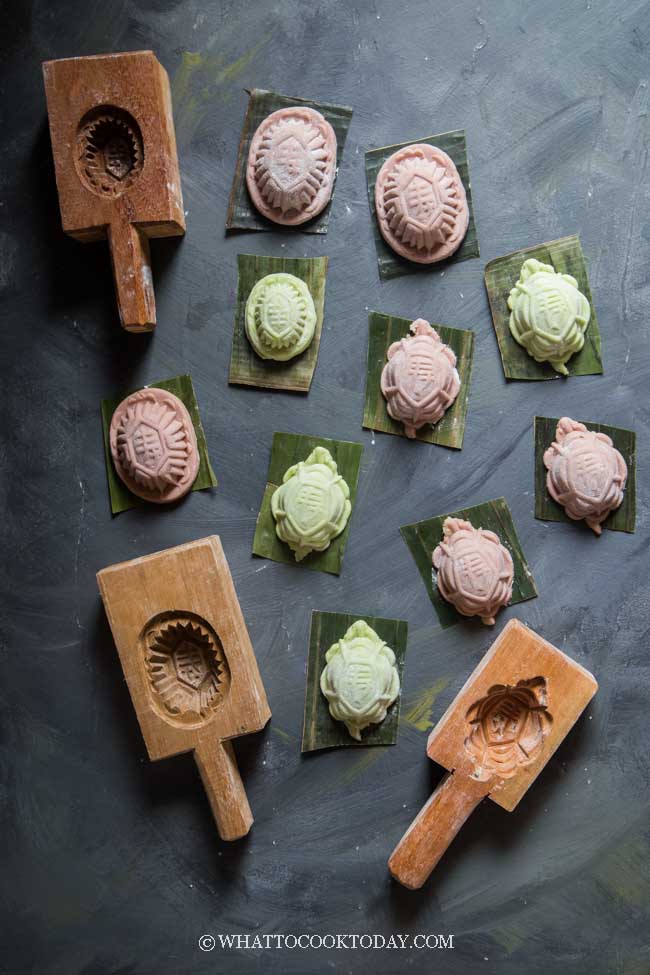
HOW TO MAKE ANG KU KUEH
1. PREPARE THE DOUGH
Mix the glutinous rice flour with salt, and sugar. Stir to combine.
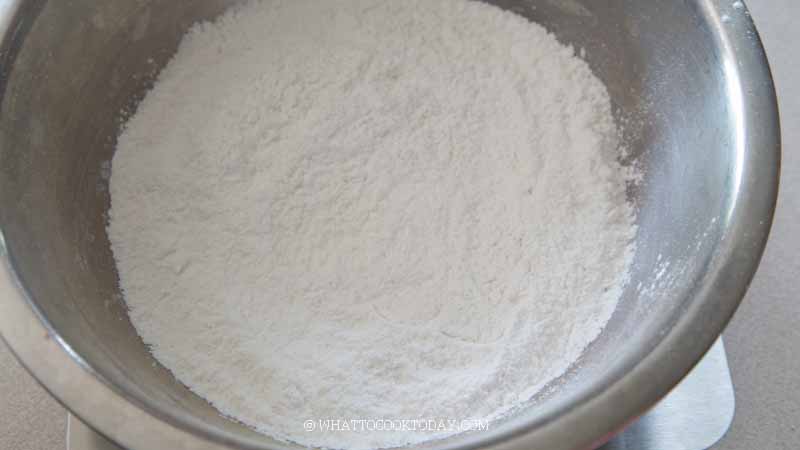
Make a well in a center. Add few drops of food coloring if you don’t use natural coloring from pandan juice and beetroot juice. If you use pandan juice and beetroot juice, put them in a saucepan (separately) and bring them to a rolling boil

boiling beetroot juice for red color
Pour the hot liquid into the center.
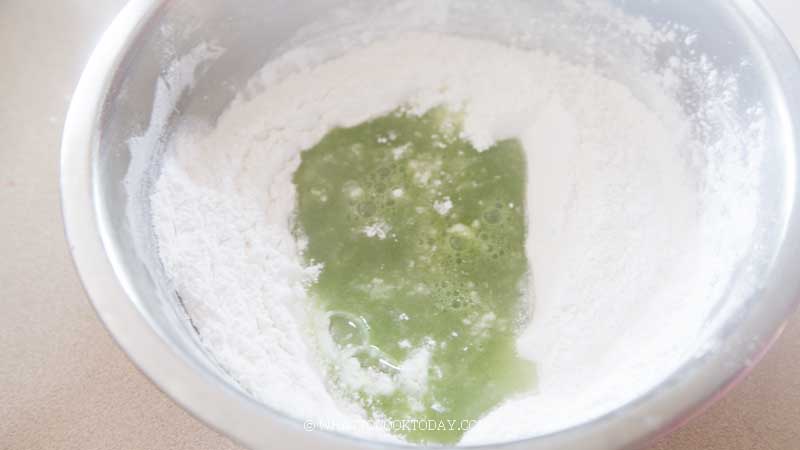
Use a rubber spatula to start stirring until it forms a crumbly dough
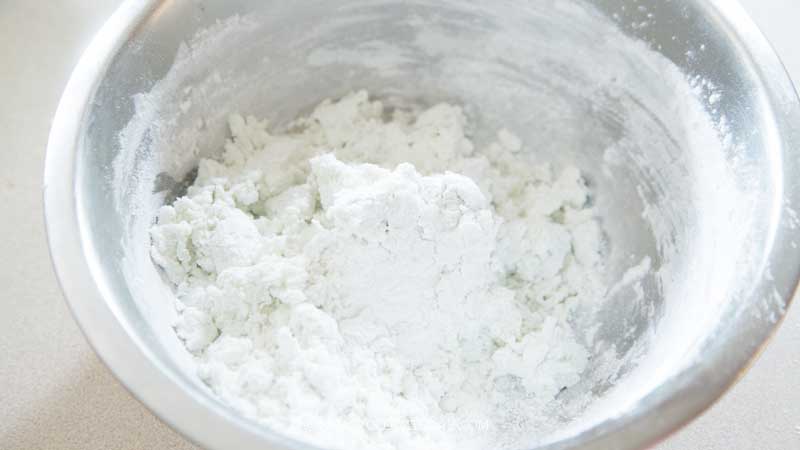
When cool enough to handle, use your hand to knead the dough into a soft, pliable and shiny dough.
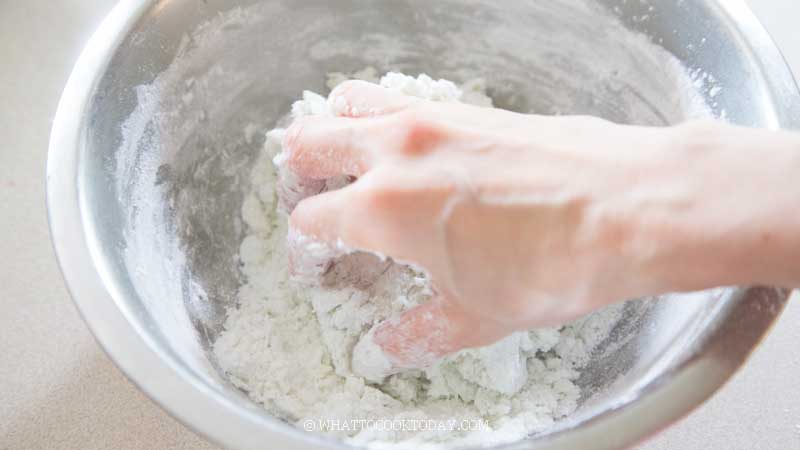
Cover and let them rest for 10 minutes.
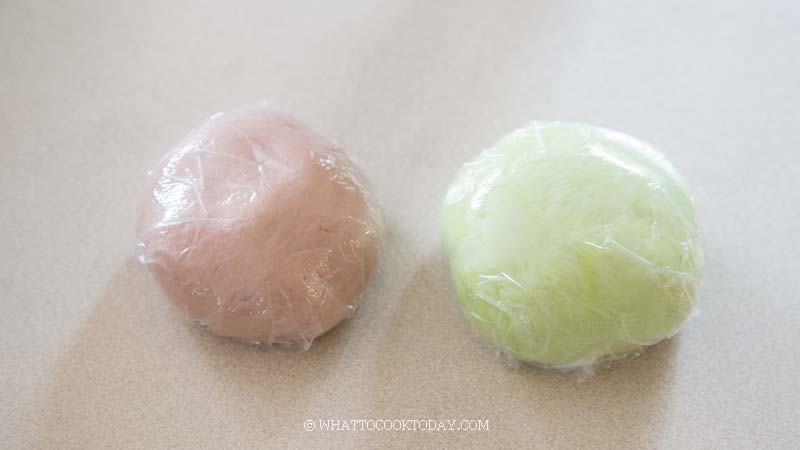
2. SHAPE THE FILLING
The amount of the dough and filling depends on the size of your mould. I have 30, 50, and 60 grams mould. For example if I use 50-gram mould, I can portion 30 grams of dough and 20 grams of filling or 25 grams of dough and 25 grams of filling.
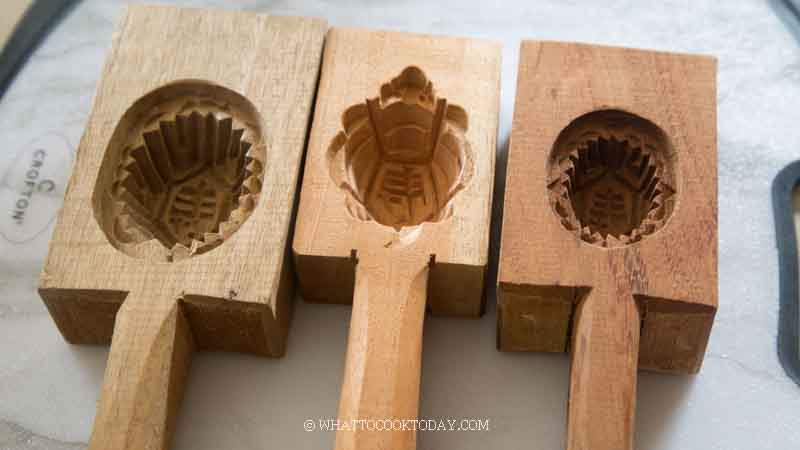
I believe you get the idea! Portion out the mung bean paste filling and roll them into balls for easier wrapping
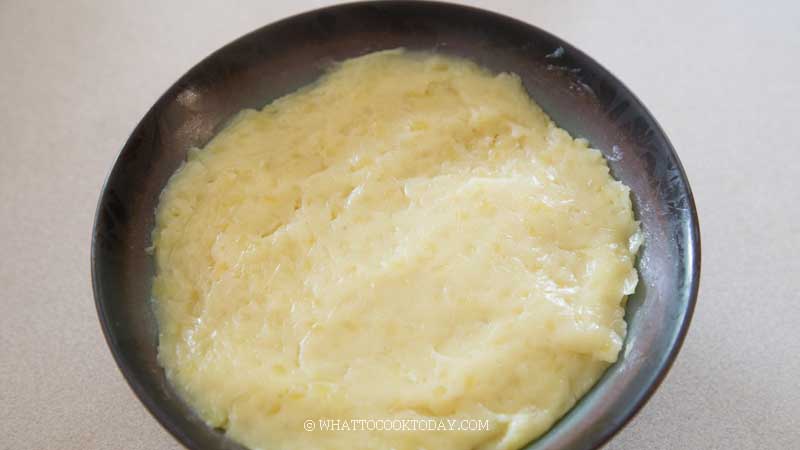
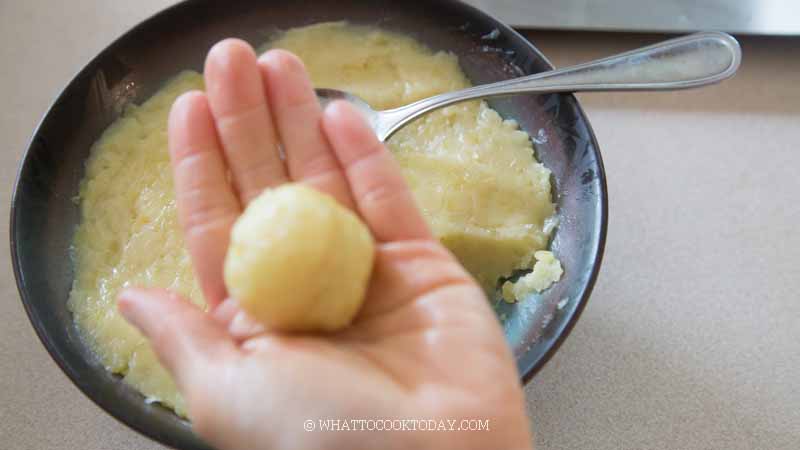
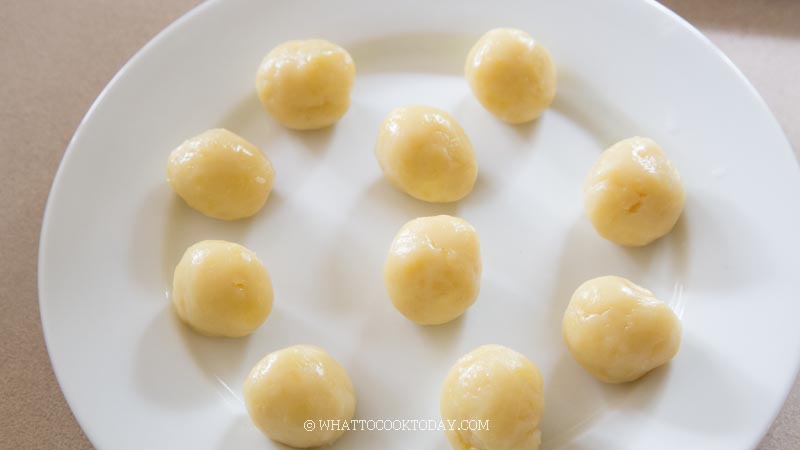
3. WRAPPING
Portion out the dough about into the size you want. Flatten them with the palm of your hand. Place the filling on the middle and bring all edge together and roll them into a smooth ball again
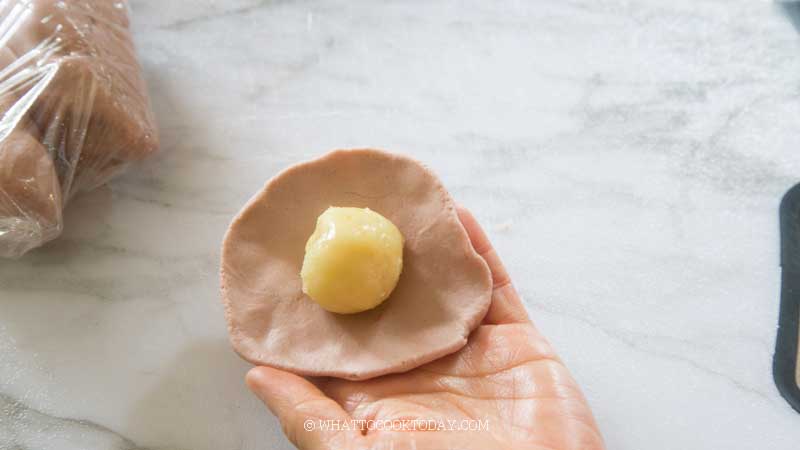
Dust the mold with some sticky rice flour to prevent sticking and gently knock off excess flour. I roll the dough ball into the flour thinly too.
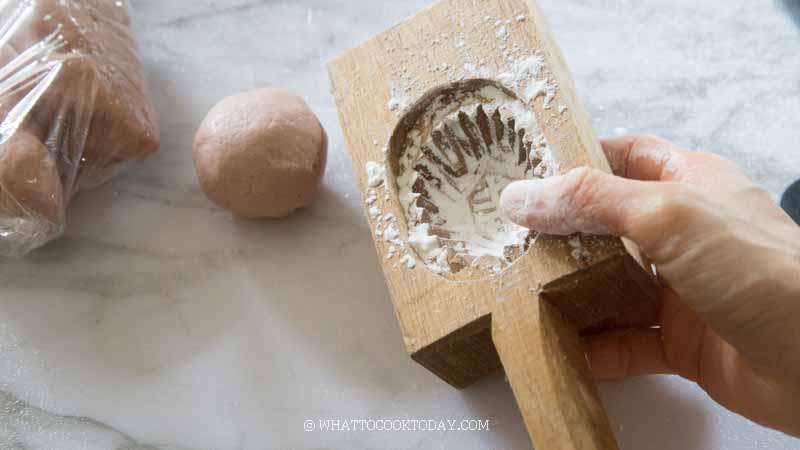
Place the dough ball into the cavity of the mould. Slightly pressed it down as you stretch them out to fit the mould.
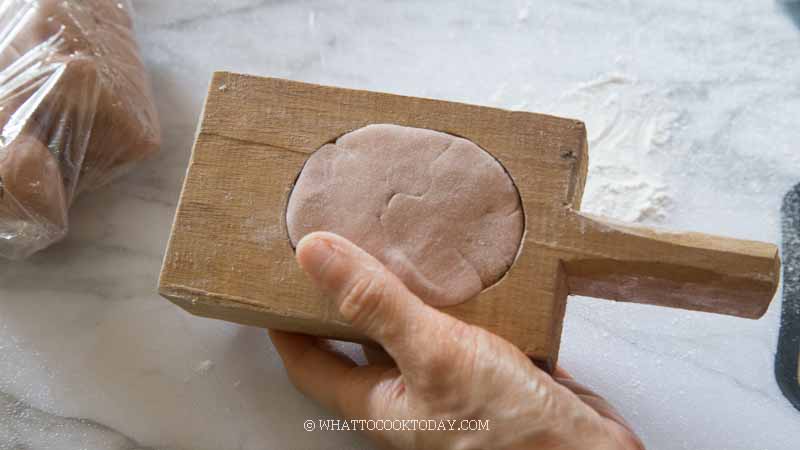
Knock the mold once or twice on a countertop (lined with some cloth to minimize banging sound) to dislodge the dough
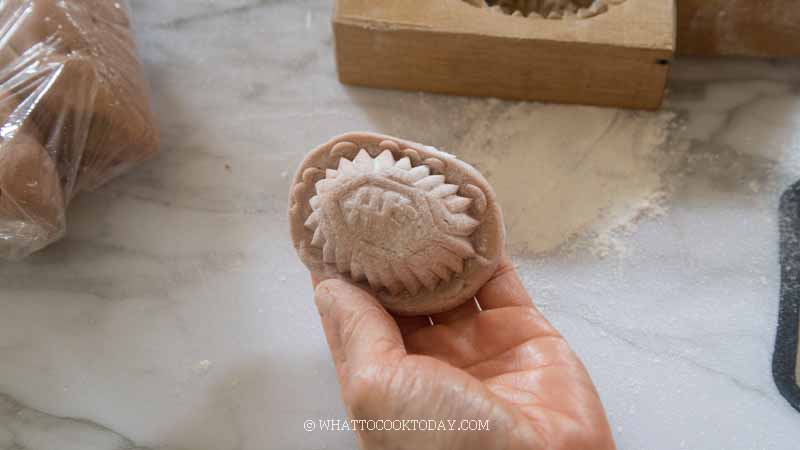
Place individual ang ku kueh on a greased banana leave

4. STEAMING
When the water in the steamer is boiling vigorously, place the ang ku kueh inside the steamer about 1/2-inch apart.
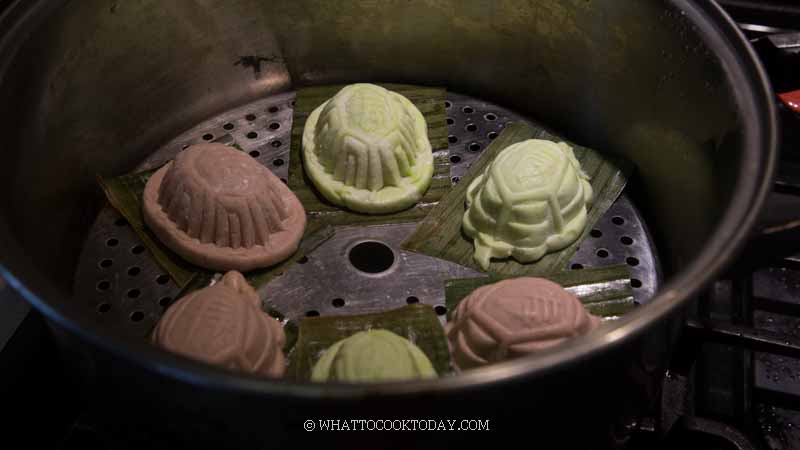
Lower the heat to medium and when you cover the lid, let it crack opens about 1/2-inch and steam for 10-15 minutes, depending on how big your ang ku kue. This is very important as it helps to maintain the imprints on the cake and to make sure you ang ku kueh is not flattened. If you steam them on high heat with all the steam trapped inside ,all the imprints will mostly be blurred and cake will expand to the side and flattened.
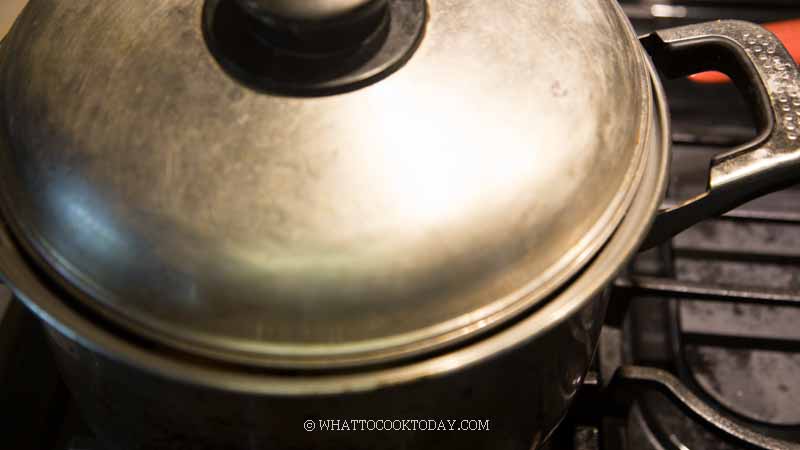
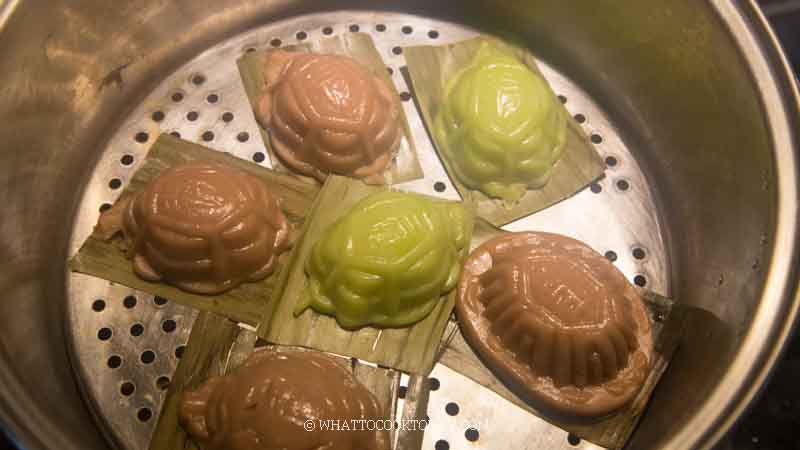
5. COOL DOWN
Remove from the heat onto a plate and then brush with some cooking oil if you like. Let them cool down completely

FREQUENTLY ASKED QUESTIONS
WHY MY ANG KU KUE DOESN’T HAVE NICE IMPRINTS ON THEM AFTER STEAMING?
That was what happened when I made it the first few times I made ang ku kueh. They came out blurred and stretched to the side. When the water in the steamer is boiling vigorously, place the ang ku kueh inside the steamer about 1/2-inch apart. Lower the heat t medium and when you cover the lid, let it crack opens about 1/2-inch and steam for 10-15 minutes, depending on how big your ang ku kue. This is very important as it helps to maintain the imprints on the cake and to make sure you ang ku kueh is not flattened. If you steam them on high heat with all the steam trapped inside ,all the imprints will mostly be blurred and cake will expand to the side and flattened.
CAN I STILL MAKE ANG KU KUEH WITHOUT THE MOULD?
If you don’t have the mold, don’t sweat it! You can just roll it into a ball and steam it as round balls. The Chinese love anything round too 😉
WHERE CAN I GET THE TORTOISE MOULD?
If you are in Asia, most likely you won’t have a problem finding one. They are available in a shop that sells baking equipment and ingredients. If you are in the U.S., you can find one at Amazon, but there isn’t much selection.
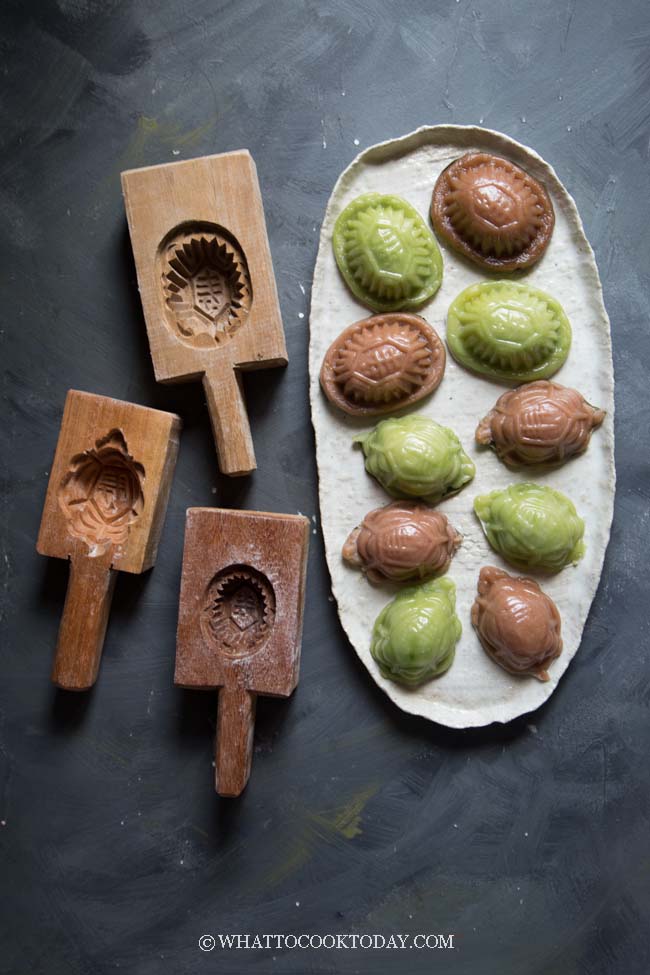
VARIATIONS YOU MIGHT LIKE
Pumpkin ang ku kueh
Pandan ang ku kueh with sweet peanut filling

DID YOU MAKE THIS EASY ANG KU KUEH RECIPE?
I love it when you guys snap a photo and tag to show me what you’ve made 🙂 Simply tag me @WhatToCookToday #WhatToCookToday on Instagram and I’ll be sure to stop by and take a peek for real!

Easy Ang Ku Kueh with Sweet Mung Bean Paste
Ingredients
For the dough:
- 300 gr glutinous rice flour (and more for dusting)
- 2 Tbsp sugar
- ¼ tsp salt
- 250 ml hot boiling liquid I used hot pandan juice and beetroot juice for natural green and red coloring, or more as needed
- 40 gr cooking oil
- 4 -5 drops of food coloring of your choice
To make beetroot juice (if you want natural red color):
- 30 gr beetroot you can also use red dragon fruit juice
- 110 ml water
For the filling:
- 1 recipe mung bean paste you can use sweet or savory version (you may have some leftover)
Others:
- Banana leaves wiped clean and cut into 3x3 inch square
- cooking oil for brushing
Instructions
To make beetroot juice:
- Place the beetroot and water in a blender and blend until smooth. Strain the juice if necessary to get a smooth juice
Prepare the doughs:
- Mix the glutinous rice flour with salt, and sugar. Stir to combine. Make a well in a center. Add few drops of food coloring if you don't use natural coloring from pandan juice and beetroot juice
- If you use pandan juice and beetroot juice, put them in a saucepan (separately) and bring them to a rolling boil. I suggest boiling a bit extra, about 100 ml extra, in case you need more liquid later,
- Pour 250 ml of the hot liquid into the center, reserve the rest for in case you need it later. Use a rubber spatula to start stirring until it forms a crumbly dough. When cool enough to handle, use your hand to knead the dough and add the oil and continue to knead into a soft, pliable and shiny dough. Adds more water as needed to get to a soft pliable state. This is important to make sure your ang ku kueh stays soft after steaming later. Cover and let them rest for 10 minutes. The dough should feels soft and won't break if you knead it.
Shaping the mung bean paste:
- The amount of the dough and filling depends on the size of your mould. I have 30, 50, and 60 grams mould. For example if I use 50-gram mould, I can portion 30 grams of dough and 20 grams of filling or 25 grams of dough and 25 grams of filling. I believe you get the idea! Portion out the filling and roll them into balls for easier wrapping
Wrapping:
- Portion out the dough about into the size you want. Flatten them with the palm of your hand. Place the filling on the middle and bring all edge together and roll them into a smooth ball again
- Dust the mold with some sticky rice flour to prevent sticking and gently knock off excess flour. I roll the dough ball into the flour thinly too. Place the dough ball into the mold. Slightly pressed it down as you stretch them out to fit the mold. Knock the mold once on a countertop (lined with some cloth to minimize banging sound) and the dough will flop out of the mold. Place individual ang ku kueh on a greased banana leave
Steaming:
- When the water in the steamer is boiling vigorously, place the ang ku kueh inside the steamer about 1/2-inch apart. Lower the heat t medium and when you cover the lid, let it crack opens about 1/2-inch and steam for 10-15 minutes, depending on how big your ang ku kue. This is very important as it helps to maintain the imprints on the cake and to make sure you ang ku kueh is not flattened. If you steam them on high heat with all the steam trapped inside ,all the imprints will mostly be blurred and cake will expand to the side and flattened.
- Remove from the heat onto a plate and then brush with some cooking oil if you like. Let them cool down completely
Storing cooked ang ku kueh:
- They can be kept at room temperature (where humidity is low) for about 3 days. If you keep them in the fridge, you just need to reheat them in the steamer for 3-5 minutes, as the skin will toughen. But once reheated, they will be soft again
- The cooked ang ku kueh can also be kept frozen in the freezer for up to 3 months and they go from freezer to steamer and steam for 8-10 minutes or until heated through
Storing uncooked ang ku kueh:
- Place them on a baking sheet not touching each other and place them in the freezer for one hour and then transfer to a freezer bag and push all the air out and seal the bag. They can be kept in the freezer for up to 6 months. When ready to steam, do not thaw. Steam over medium heat with the lid crack open about 1/2-inch and steam for 15 minutes or until heated through


24 comments
Hello! Can I ask if the consistency of the paste has to be hard? I am wondering if i make it soft, it will be softer after steaming?
Hi Rabiah,
The consistency of this paste is not hard at all. It’s mold-able but not hard if that’s your concern.
Hi,food colouring is added at which point? Your recipe stated “add food coloring, and oil to the water “,are you referring to the hot water and this step is done before hot boiling water is poured into the flour? Hope you can clarify. Thanks.
Hi Rachel, the food coloring and oil are added after you added the hot water and then stir everything together. sorry for the confusion. I’ve reworded the recipe. Hope it’s clearer now. Let me know if anything else I can clarify. Thank you for letting me know!
Hi, Will it be better to freeze the uncooked ones or the cooked ones?
Hi Audrey,
That’s a good question, I haven’t tried to freeze uncooked ang ku kueh before. But I don’t see why it won’t work. If you do freeze the uncooked kueh, you should steam them without thawing. Please let me know how they turn out if you try it. I will try that out too next round when I make ang ku kueh.
Hi, Can you please help me find plastic mould(shallow type) for Ang Ku Kue somewhere in Kuala Lumpur, preferably near Jalan Petaling?
My daughters are travelling to Malaysia and we hope to buy some.
Thank you so much.
Hi Roberto, I really wish I can give you some recommendation, but I’m not familiar with KL and I live in the U.S. My mom actually got one for me from Singapore, I know they have a plastic type too. So sorry, I have no idea where to find at KL :/
Is ang ku kueh peranakan? Which festivals do they eat it most frequently?????? I need the information urgently!!!
I don’t think ang ku kueh is peranakan. Lots of kueh or kuih are from peranakan cuisine, but I don’t think ang ku kueh is one of them though. I always thought ang ku kueh is Chinese pastry from Southern China ? It may have been adopted by the peranakan too, but definitely not originated from there. I know we serve ang ku kueh on birthdays, I’ve seen it during wedding too, or important events like open house, etc.